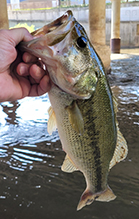largemouth bass
(Micropterus nigricans)
Conservation • Description • Habitat • Ecology • Distribution • Taxonomy
|
|
||||||||||||||
Description |
Largemouth bass is a common native fish. Its native range is the United States and southern Canada east of the Great Plains. It has been intentionally introduced for sportfishing throughout the western U.S. as well as in Europe, Japan, South Korea, China, and South Africa. Largemouth bass are found in a variety of habitats, including large and small lakes, reservoirs, ponds, rivers, and creeks. They prefer clear water with sandy bottoms and abundant vegetation. They are commonly found in areas with submerged logs and rocks. Largemouth bass are opportunistic feeders, and they will consume any prey that will fit in their large mouths. The typical lifespan in the wild is 15 to 23 years. The size of an adult fish depends on its age, food availability, water temperature, and other environmental factors. Largemouth bass are typically 2″ to 8″ (5 to 20 cm) in total length after one year, 2¾″ to 12½″ (7 to 32 cm) long after two years, 6″ to 14½″ (15 to 37 cm) long after three years, and 8″ to 16″ (20 to 41 cm) long after four years. However, they live longer and they can get much larger. The record largemouth bass caught in Minnesota weighed 8 pounds 15 ounces, was 23″ in length, and was caught in Auburn Lake in Carver County in 2005. There is currently no state catch and release record for largemouth bass. The mouth is large. The upper jaw extends back past the eye in fish longer than 4″ (10 cm). The eyes are golden brown. There are 9 to 12 rows of scales on the cheeks. They are about the same size as the scales on the bony flap that protects the gills (operculum). The body is elongated and thick. It is stocky, slightly laterally compressed, and oval in cross section. The body color is olive gray to shiny green on the back and the upper sides, and silvery green to yellowish green on the lower sides, with a heavy black stripe on each side separating the two areas. The lower sides may be speckled, but they do not have rows of small spots. The black stripe is prominent on young fish, but it fades, typically breaking up into a series of blotches, as the fish reaches maturity. The belly is white or cream colored. The dorsal fin is deeply divided. The front portion has 9 spines and is only slightly rounded. It is almost separated from the softer rear portion, which has 12 to 14 rays. The anal fin has 3 spines and 11 to 12 rays. The pectoral fins have 13 to 17 rays. The row of pores that runs from the gills to the tail (lateral line) has 58 to 72 scales. |
Size |
Typical total length 1 year old: 2″ to 8″ (5 to 20 cm) 2 year old: 2¾″ to 12½″ (7 to 32 cm) 3 year old: 6″ to 14½″ (15 to 37 cm) 4 year old: 8″ to 16″ (20 to 41 cm) |
Similar Species |
Habitat |
Large and small lakes, reservoirs, ponds, rivers, and creeks |
Ecology |
Behavior |
|
Lifespan |
15 to 23 years |
Life Cycle |
|
Food |
Any prey that will fit in its mouth. |
Distribution |
||
|
Sources Biodiversity occurrence data published by: Minnesota Biodiversity Atlas (accessed through the Minnesota Biodiversity Atlas Portal, bellatlas.umn.edu, 6/30/2025). Nonindigenous Aquatic Species (NAS) information resource for the United States Geological Survey Mundahl, N.D. 1994. Distribution of fish species within ten watersheds in southeastern Minnesota. Final report submitted to the Minnesota Department of Natural Resources. Unpaged. |
|
| 6/30/2025 | ||
Occurrence |
||
Common |
||
Taxonomy |
|
Gigaclass |
Actinopterygii (ray-finned fishes) |
Superclass |
Actinopteri |
Class |
Teleostei |
Order |
Centrarchiformes (freshwater sunfishes, grunters, and allies) |
Suborder |
Centrarchoidei (freshwater sunfishes and relatives) |
Family |
Centrarchidae (freshwater sunfishes) |
Subfamily |
Lepominae |
Genus |
Micropterus (black basses) |
Genus Higher level taxonomy |
|
Subordinate Taxa |
|
|
|
Synonyms |
|
Aplites salmoides Grystes megastoma Grystes nigricans Grystes nobilis Grystes salmoides Huro nigricans Huro salmoides Labrus salmoides Micropterus salmoides ssp. salmoides Perca nigricans Pikea sericea |
|
Common Names |
|
black bass largemouth bass northern largemouth bass |
|
Glossary
Lateral line
In fish: A faint row of pores along a fish’s body from the gills to the tail. It allows the fish to detect movement, vibrations, and pressure gradients in the water around them.
Maxilla
A paired structure that forms a significant component of the mouth apparatus across various animal phyla. In vertebrates: A major bone of the upper jaw (or the snout) that typically bears teeth. In Arthropods: An accessory appendage behind the mandibles used for manipulating food and often bearing sensory palpi.
Operculum
On mosses: A lid or cover that covers the opening of a capsule and detatches at maturity. On snails: The horny or calcareous door-like structure that seals opening of the shell. On fishes: A bony flap on the rear side of the head that protects the gills.
Visitor Photos |
||
Share your photo of this fish. |
||
This button not working for you? |
||
Gregory Gilman |
 |
Caught and released this am |
MinnesotaSeasons.com Photos |
||
|
||
|

Slideshows |
|

Visitor Videos |
||
Share your video of this Fish. |
||
This button not working for you? |
||
|
Other Videos |
||
Green Bass on the green fly |
About
Jun 27, 2025 |
Largemouth Bass (Micropterus salmoides) |
About
Sep 13, 2020 |

|
Created: 6/30/2025 Last Updated: © MinnesotaSeasons.com. All rights reserved. |


